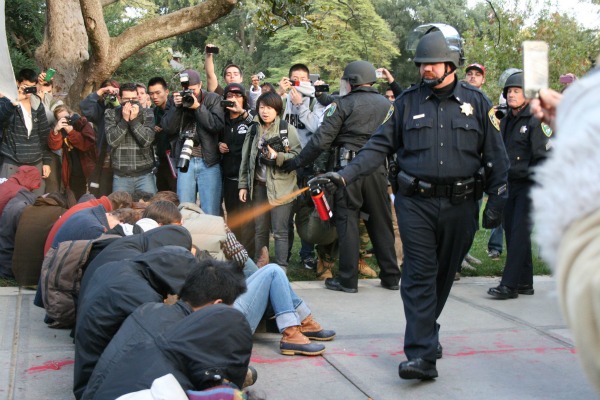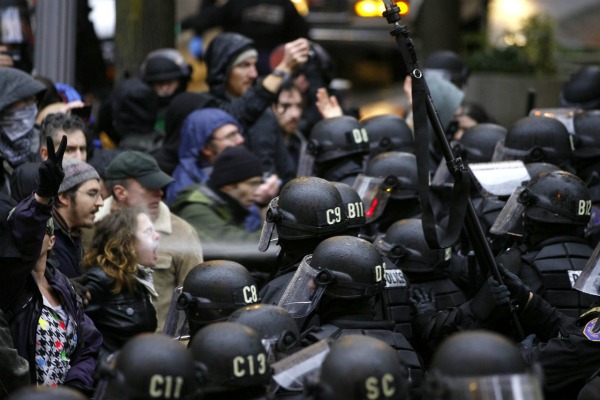Too Much Violence and Pepper Spray at the OWS Protests: The Videos and Pictures
The dousing of seated, non-violent students with a chemical agent at U.C. Davis should provoke a call for restraint. These images show their experience is not unique.

Police dressed in riot gear at U.C. Davis on Friday afternoon used pepper spray to clear seated protesters from the university quad where they had set up a small Occupy encampment, pro-actively and repeatedly dousing the passively-resisting students with a chemical agent designed to cause pain and suffering in order to make it easier to remove them.
It is hard to look at this kind of attack and think this is how we do things in America.
And yet it is all too American. America has a very long history of protests that meet with excessive or violent response, most vividly recorded in the second half of the 20th century. It is a common fantasy among people born in the years since the great protests movements -- and even some not so great ones -- that they would have stood on the bold side of history had they been alive at the time and been called to make a choice. But the truth is that American protest movements in real time -- and especially in their early days -- often appear controversial, politically difficult, out-of-the-mainstream, and dangerous. And they are met with fear.
Even decades later, acts of protest can be the subject of heated debate and lead people to question (as well as celebrate) the moral standing of those who put their bodies on the line during moments of historic tumult -- as Sen. John Kerry, Vietnam veteran and former anti-Vietnam protester, learned during his presidential bid in 2004.
This sort of dynamic holds for pretty much any group that aims to upend the existing social order using direct action, because few resort to such tactics if they think they have other, easier ways to petition for redress of grievances or could be heard as loudly through existing channels of expression. The Tea Party movement, for example, has held many protests but with few exceptions has stopped short of civil disobedience, finding early on that its members were by and large not willing to face arrest and that it could gain power relatively quickly through the political system by backing challengers in Republican primaries and allying with experienced party operatives. The Occupy movement is both very new and rather diffuse so far, and appears less interested in gaining power than making power uncomfortable and raising far-reaching questions and public awareness.
Just over two months old, it has succeed in changing the terms of the national debate about income inequality in this country with shocking rapidity. And whether it flames out in a rash of alienating and chaotic street clashes or builds into a goal-oriented and sustainable force in American life -- sustainable as any protest movement, that is, which is to say not very -- it's clear it has already made one of the most significant interventions into the national debate on economic equality in years.
Which brings us back to the video of what happened at U.C. Davis yesterday: Non-violent students passively resisting both university and police directives to clear the area were subjected to acts of brutality that cannot be morally justified by any accounting of the facts on the ground. The raw video of yesterday's pepper-spray incident has rightfully gone viral since hitting the web last night. It is appalling:
Here's the same incident videotaped from a different perspective:
Junior faculty member Nathan Brown, an assistant professor of English at Davis, says what actually happened was even worse than what's shown on the videos, and has called on U.C. Davis Chancellor Linda Katehi to resign -- a call that has since last night become a petition. His description:
Without any provocation whatsoever, other than the bodies of these students sitting where they were on the ground, with their arms linked, police pepper-sprayed students. Students remained on the ground, now writhing in pain, with their arms linked.
What happened next?
Police used batons to try to push the students apart. Those they could separate, they arrested, kneeling on their bodies and pushing their heads into the ground. Those they could not separate, they pepper-sprayed directly in the face, holding these students as they did so. When students covered their eyes with their clothing, police forced open their mouths and pepper-sprayed down their throats. Several of these students were hospitalized. Others are seriously injured. One of them, forty-five minutes after being pepper-sprayed down his throat, was still coughing up blood.
As Will Wilkinson tweeted last night of the pepper-spray wielding officer identified as Lt. John Pike, "It ought to be possible to sue the pants off this guy and win."
The U.C. Davis police department has, not surprisingly, defended its actions. Ten students were arrested -- eight men and to women -- and about a dozen others were sprayed, according to the Davis Enterprise.
The nearest I got to Zuccotti Park before it was cleared earlier this week was passing it in a cab one night in New York; it appeared a small and forlorn collection of tents in what was by late October a very cold rain. Visiting McPherson Square in Washington, D.C., for the first time with Atlantic contributor Tina Dupuy earlier this month, I met union members and teenage college students trying to put their Habermas into action and create of a new public square in the form of Occupy DC. It seemed kind of sweetly literal -- building tents as a physical attempt at a structural transformation of the public sphere? -- and largely harmless to anyone but the protesters, because grungy and jerry-rigged and relatively defenseless against the elements or potential criminals. But since McPherson normally is a bit of a dead space in the city -- there are some residential buildings near it, but it's mainly surrounded by office-workers who clear out on evenings and weekends -- it didn't seem to be bothering anyone.
Perhaps Washington's still-intact Occupy encampment has been treated more gently than those in other cities because protests in the nation's capital are as routine and unremarkable as are the city's frequent rains. Between the easy co-existence with protests here, and the fact that the Occupy encampments and demonstrations across the country have been covered as much as regional stories as a national one, it's easy to have missed the truly shocking number of violent confrontations that have taken place as the anti-Wall Street movement has extended its reach.
Last night's video should serve as a wake-up call. Below are some of the other dramatic moments in the ongoing confrontations between Occupy protesters and police. Taken together, they paint a disturbing portrait that should at a bare minimum call into question the standards and practices police officers around the nation have developed for deploying pepper spray, which has only become a universal policing tool within the past 20 years. And they raise real questions about whether disproportionate police responses to the movement's intentional acts of civil disobedience have in some cases increased social disorder rather than restored calm.
Portland, pepper spray:


Berkeley, batons:
Oakland, rubber bullets:
Oakland, tear gas:
Denver, pepper spray:
See also: